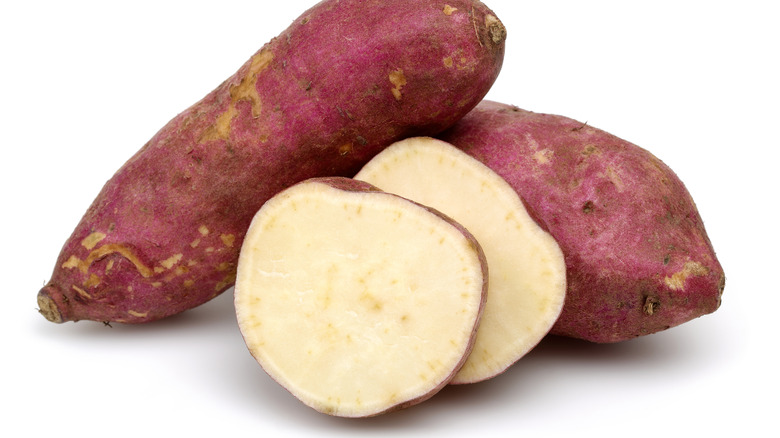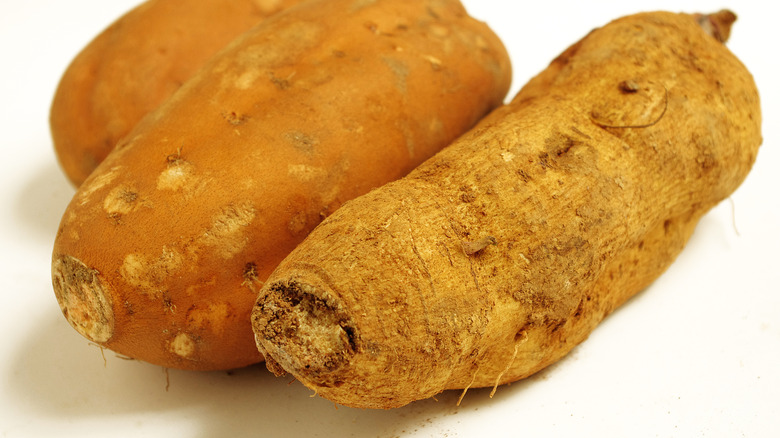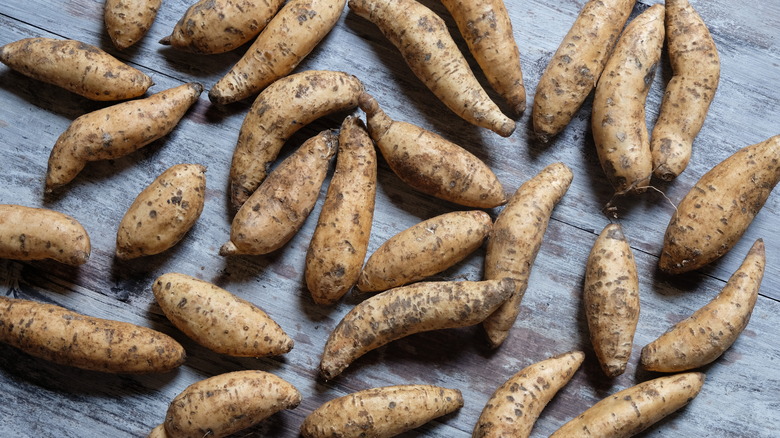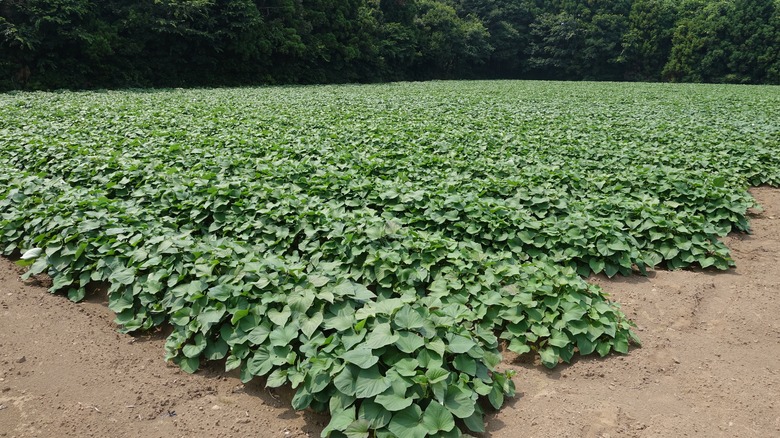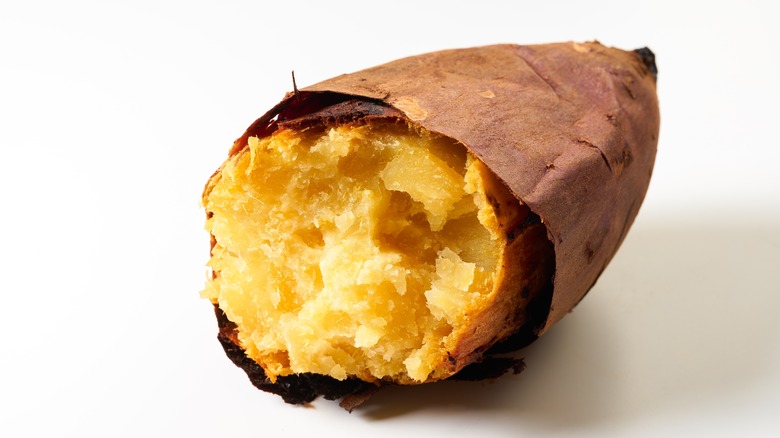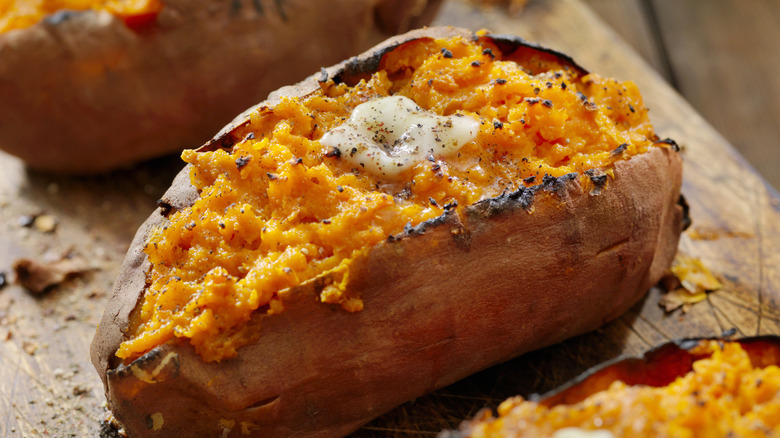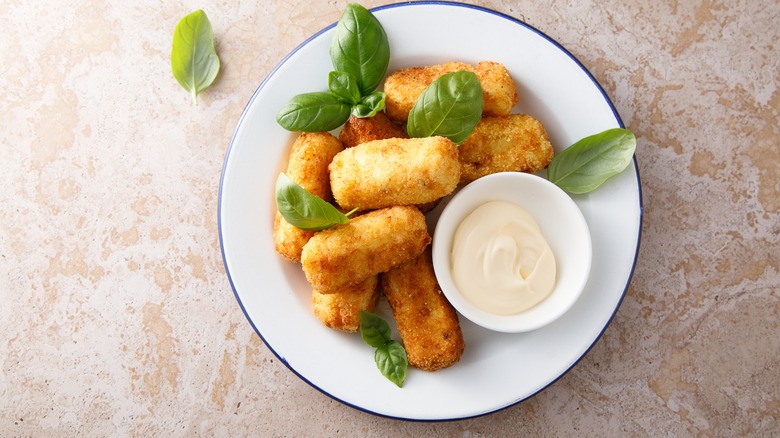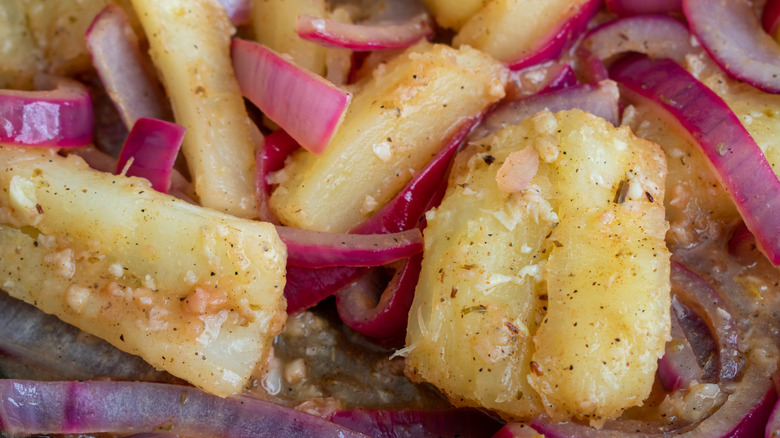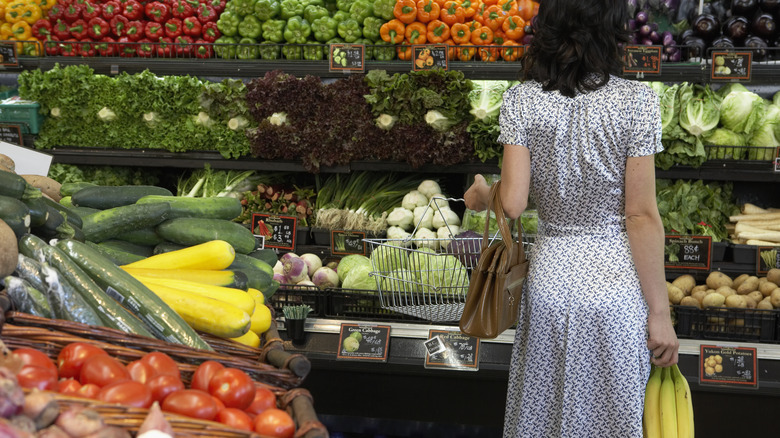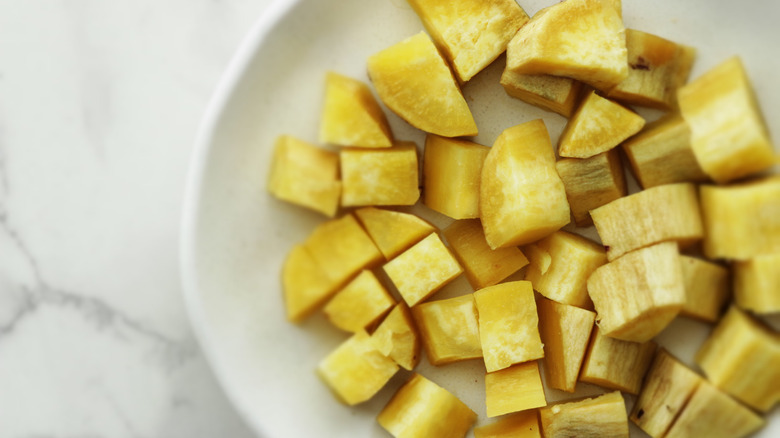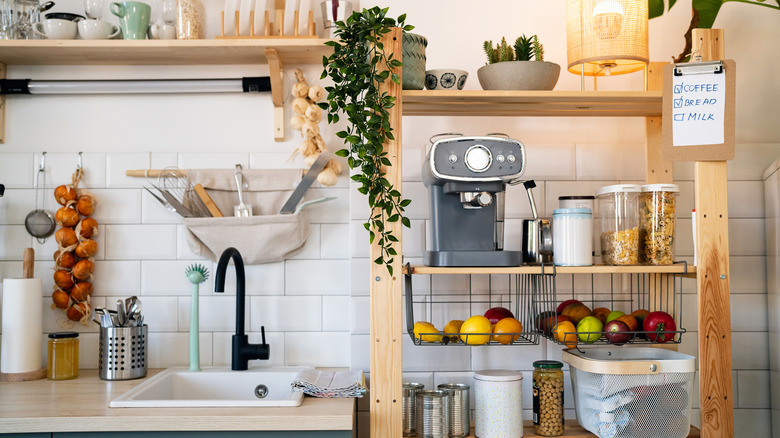Boniato: The Caribbean Sweet Potato That You May Mistake For A Yam
Boniato, botanically classified as ipomoea batatas, is a member of the tuber family that often flies under the radar or gets mistaken for a yam. Many Cubans, Columbians, Dominicans, Peruvians, and other communities across Central and South America will know this ingredient like the back of their hand, willingly and readily setting the record straight for whomever might be unfamiliar.
Boniato is a workhorse of an ingredient, known for providing anyone who cooks or eats it with long-lasting energy, by way of its subtly sweet, nutty, white flesh. Grown in tropical and subtropical climates, boniato is a mainstay in slow cooking across a number of cuisines. It is not a vegetable that likes to be rushed — not in its cultivation, its cooking, or its eating —though it may be hard to stop yourself from lapping it up by the forkful.
Boniato is eaten year-round, and grown year-round, too, in areas like Cuba, parts of Asia, and Southern Florida where two varieties are grown; "picadia" in autumn/winter, and "campeon" in the summer. However, as many parts of the world head into winter, a season associated with slow cooking now is just as good of a time as any to help you find, purchase, and cook this delicious root vegetable.
What is boniato, what does it look like, and where does it come from?
Like the humble sweet potato, boniato is a tuber. Unlike other sweet potatoes you'll find at your local grocery store boniato's flesh is white, with a drier, starchier, less sweet flavor. The name boniato comes from Spanish, which roughly means "harmless" in English.
Round and bulbous in the middle with slightly tapered ends, boniato resembles a sweet potato or yam in its shape, though can often be quite large. The skin can range in color from dusty pinks to light browns and muted purples. Bonaito is grown in various parts of the world but thrives best in tropical and sub-tropical environments. It had been grown quite extensively in the pre-colonial Western Hemisphere where it originates, in Central and South American areas like Cuba, Brazil, Peru, and Mexico. Boniato has traveled to other regions including areas of Asia, where it now remains as the largest global producer of the yam-like tuber.
South Florida's tropical climate also makes for perfect growing conditions, heightened by the large Cuban diaspora influence and its presence in Cuban cuisine. The conditions of culture and climate make for the perfect storm, with nearly 5,000 acres of boniato produced annually from Miami-Dade County, according to The University of Florida.
What is the history of boniato?
Boniato is thought to have originated as far back as 1,000 BC in Columbia and Peru. Boniato is also known by many other names, including batata, camote, Cuban sweet potato, kamura, or yellow sweet potato depending on where in the world you live and what language you speak. It was introduced to Cuba, and elsewhere by migratory indigenous communities of Taínos, who later introduced the same plant to Spanish colonizers.
Despite its origins in the Western Hemisphere, namely Central and South America, boniato also made the long journey to Asia, via pre-Incan explorers. Asia is now where most boniato cultivation takes place. Like other tubers that combine carbohydrates with fiber as a source of long-lasting energy, boniato is invaluable as a product, prevalent in a variety of cuisines and dishes across areas of South and Central America. Boniato is often grouped with other similar tubers and root vegetables like yams, taro, yuca, and potatoes. Batata, as it's called in Dominican households is often served as an easy side dish, either boiled, roasted, or fried, and can be eaten at any time of day from breakfast through to dessert.
How is it grown?
Boniatos can be grown and cultivated much like sweet potatoes. They grow best in tropical and subtropical climates as the plants don't adapt well to cold weather. Plants are spaced around a foot apart when grown, with rows spaced even further apart, allowing for between 3 to 4 feet in between each row for optimal nutrients and growth. For those considering growing the tuber themselves, the yield of boniato plants is lower than that of sweet potatoes, so something to be aware of as you get planting.
Plants will generally take between 120 to 180 days from planting to harvest. Unlike sweet potatoes which can lie around for weeks after harvesting, boniatos spoil quickly so they should be eaten within a few days of picking for optimal flavor and texture. Though boniato can be incredibly dense, they're not as tough as they appear and can start to develop bruises and soft spots quickly.
Currently, there is considerable boniato commercial cultivation in Miami-Dade County in South Florida. There, two varieties are grown (one in the cooler months and one in the warmer), known as "picadia" and "campeon". Not only is the weather favorable, but the large Cuban and Latin communities create a high demand for the tuber, as it is used widely within their cuisines. For this reason, boniatos are also popular domestically, grown in backyards and home gardens, though a substantial amount of space and access to roots for regrowth, can be challenging.
What boniato tastes like
Boniato's taste is very different from that of its sweeter, oranger, tuber cousin. Boniato is known for its mild sweet-meets-starchy flavor and fluffy texture. Boniatos are also known to be wonderfully aromatic when cooked, with chestnut-like scents serving as a precursor to their earthy, nutty taste, gentle sweetness, and satisfying starchy, dry texture. You can practically taste their highly effective nutritional composition of fiber-meets-carb makeup with each bite. Some consider it to be somewhat of a cross in taste and texture between a sweet potato and a white potato but, its pronounced chestnut-like flavor really puts the tuber in a category of its own.
Like sweet potatoes, boniato leaves are also edible by stir-frying or sautéing them. Many liken them to kale, but less hearty with a mellower, less bitter flavor. Also, like sweet potatoes, the skin or peel covering the boniato is edible. However, it is highly fibrous, so unless you have a particularly robust digestive system, you may want to avoid eating it, especially in large quantities. Most cooking preparations call for the skin to be removed, or if baked whole, the flesh to be scooped out and the shell discarded. The bulk of the root vegetable's flavor comes from under its surface, anyhow.
How is boniato different than sweet potato?
There are several characteristics that set boniato apart from yam or sweet potato, the first being its appearance. Boniatos are known for having rougher, bumpier skin than the average sweet potato. Rather than coppery orange, boniato skin is lighter, ranging from light brown to a dusty rose or even a slightly brownish-purple.
Not just skin deep, the flesh of a boniato is also different in color, texture, and in taste. Boniato's flesh is often white, with a dry, fluffier texture closer to a white potato than its silky, sweet, orange counterpart. Boniato is also considerably less sweet in taste, with many noting its subtle, earthy sweetness and chestnut-like flavor. Unlike sweet potatoes, which can have a relatively short cooking time and long shelf life, boniatos are the exact opposite. These tubers must be cooked shortly after picking or they will begin to develop soft bruises and lose their subtle, nutty sweet taste. Due to their density, boniato also takes longer to cook than the average sweet potato.
How to cook with boniato
Much like yams or sweet potatoes, boniato can be roasted, baked, mashed, steamed, fried, and boiled. Though the skin is edible, many choose to remove it. Due to its high fiber content, it can be difficult to digest, like with other tuber and sweet potato skins.
Boniato is used widely throughout the Caribbean and much of South American cooking, from sweet potato pie to papas rellenas — a Peruvian dish comprised of mashed potato, formed around a pocked of spiced minced beef and tomato which is then deep fried until crispy.
Add them to stews, roast them with maple syrup, nutmeg, cardamom, cloves, or simply butter. Boniato can also be boiled and served with a simple sauce like mojo de ajo, or garlic sauce. As boniatos are denser than potatoes or other tubers they will take around an hour or so in a 400 F oven, so plan accordingly. You'll also want to rotate them periodically to cook through entirely, due to their density.
How is boniato used in Cuban cuisine?
Boniato is considered to be an indispensable ingredient within Cuban cuisine and culture. It is a staple ingredient in dishes like ajiaco, a thick soup made in a number of varieties across Central America from Cuba to Columbia that consists of meat, largely pork or beef, boniato, and other root vegetables. Ajiaco Cubano generally begins with a sofrito; onions, garlic, and peppers, and builds from there into a hearty, slow-cooked stew.
Historically, boniato leaves can also used medicinally, made into beverages and teas to help encourage breastfeeding and aid healing after birth or battle. The tuber can also be incorporated into a number of desserts, including Cuban sweet potato pudding, a kind of sweet potato-like pudding but shouldn't be substituted for the sweeter, softer, oranger variety. There are a variety of other Cuban dishes (alongside many other cuisines) that use boniato. Sometimes boniato is included in the dish in place of potato, but oftentimes times the tuber is sought after, a staple ingredient in its own right.
Where to buy boniato
Boniato can often be found in many Latin American grocery stores, grocers with a large Latin or South American and Asian produce section, or shops in areas with large numbers of Latin American residents, as they will likely serve the demands and needs of relevant local communities and shoppers. When selecting your produce, it helps to treat this tuber like any others, choosing items that are firm to the touch without any major discoloration. As boniatos are denser than yams, sweet potatoes, or potatoes, it's advisable to choose slightly smaller produce, especially if cooking with other tubers or potatoes for even cooking times. They can be quite large so this is worth keeping in mind as bigger is not always better, especially if you're cooking under a time crunch.
If you can't manage to find a boniato at your local supermarket or specialty supermarket, you can always browse online. In this day in age, most hard-to-come-by ingredients can be sourced right at your fingertips, if, of course, you're willing to pay for the convenience of not leaving your sofa. Amazon currently sells boniato in its grocery department, however also keep in mind these are ingredients that spoil easily, so you may want to search out local options first. Instacart also sells boniato, currently priced at $0.71 per pound, which will likely change based on the shopper's location.
Nutritional information about boniato
Boniatos are good sources of vitamin C, vitamin A, potassium, antioxidants, and fiber. High in both carbohydrates and fiber, this winning combination provides slow-release, long-lasting energy to help fuel physical endurance and activity. In fact, this is one of the reasons the tuber made it from the Americas to around Europe during the 1600s; it's a fantastic source of sustained energy output, which at that time was necessary fuel to sustain everyday life.
Boniato's antioxidant-rich flesh and skin are known to help support and protect the body against a variety of diseases, alongside anti-inflammatory properties. Its source of vitamin A, vitamin C, and potassium alongside calcium and magnesium is good for providing strong immune support, strength, and repair. Boniatos are overall a healthy, nutritious food that can be enjoyed simply and regularly. They are considered to be good food for those suffering from anemia due to their amount of digestible iron and have a high amount of flavonoids and beta-carotene to help manage stress. And they taste good.
How to store boniato
Now that you're convinced boniatos are for you (because they are!), it is imperative to know how best to store them. Despite their density, this tuber doesn't like to hang around for too long. Boniatos will keep for up to 10 days or so, if stored in a cool dry location at no more than around 60 F to 65 F. The longer the boniato remains unused on your shelf, however, the less flavorful it will become, so ideally it's best to use it within a few days of purchase for maximum taste.
Though it may seem counterintuitive, boniatos, unlike sweet potatoes do not fare well when refrigerated, so it's best to resist any instincts to pop them into the fridge for safekeeping. Should you start to notice any discoloration around the skin or soft spots when feeling the tuber, that is a sign of rapid aging. Like avocados, boniatos operate under the "use me or lose me" rule, so the faster you can get your tubers peeled and roasted, steamed, stewed, or into a bath of rapid boiling water, the better for you and the root vegetable.
Should you need to, boniato can also be peeled, chopped, and frozen raw in an airtight container. So if you're worried about using up the tuber in time before it starts to spoil, prep and freeze it for boiling, steaming, stewing, or mashing at a later date.
